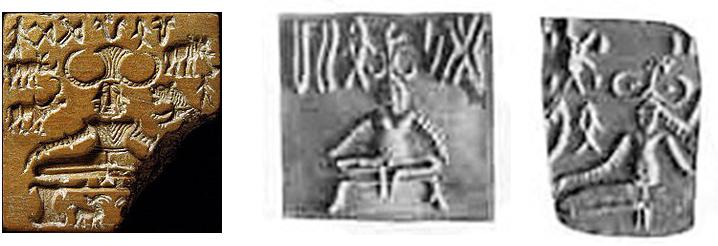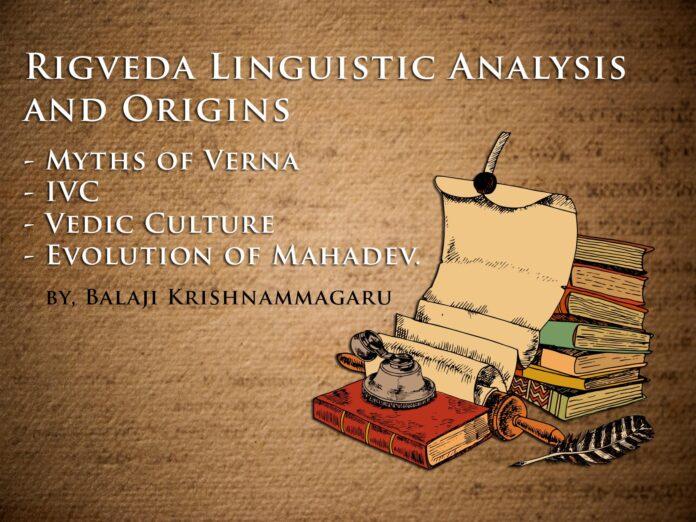Balaji Krishnammagaru – Jansankalp Foundation
A Pure Linguistic, Archeological, Science based Materialistic View on My Faith
- Pre Vedic Roots of Mahadev \ Pashupati \ Shiva \ Rudra \ Worship of Linga
- Rigveda (apauruṣeya , Śruti ) and its Origins in India and a Parallal , Intertwined Pastoral \ Semi Nomadic and Village culture with Urban Centered Indus Vally Culture
- Importance of River Sarasvati (For Rigvedic Roots in India)
- Indus Valley Civilization
- Origins of Yoga

Association of Mahadev with Lingam is also another aspect. After all I came from Tirupati and I will refer to Gudimallam
https://en.wikipedia.org/wiki/Gudimallam_Lingam
Note: This is materialistic view of my own faith . I call this other side of coin, Science . Here, my own perception as a human being, who is convent educated and science focused view . I will write someday on my own belief systems purely on faith . I am hope both will converge some day which I call it as Moksha 🙂 ? finding the ultimate Truth ? Who knows I will take concepts from Bramhanda Purana, Bramha Purana and other “Ancient Theoretical Physics” papers written thousands of years back by observations , attached God to it so that people would read with “Shradda” and debate and make it better by debating using Tarka sastra . Unlike other scriptures . Scriptures in Bharata are to be treated as theoretical scientific papers and to be debated , discussed , updated can also propose alternate explanations .
Dharma is empirical in nature and is not fixed. I always give one example. The Dharma of a King 1000 years back is to kill Tigers to protect people and go on hunting expeditions . But, Dharma today is to protect the same Tigers as their population is dwindling . Dharma is so simple. Today I am duty bound to follow constitution of India and still debate clauses \ laws if anything is outdated . Its not fixed .
Now coming to the subject , the generally accepted date for Rigveda is much earlier to 2000 BC and often goes back to 4000 BC. Its origins are in Bharath as there were numerous references to River Saraswathi which dried out in 1500 BC. There are many emerging evidences in IVC sites (I am not giving any references for now) with fire alters and other Vedic Elements .
Here, Iam not writing in a structured way, there are many tangents proposed and I will make efforts to write about each tangent. The idea is to establish or find truth with scientific acceptable geological, linguistic , gene mutations and actual archeological evidences and connects the dots.
Linguistic analysis and reordering based on language constructs
Rig Veda were recomposed, passed down orally for 10ks or 1Ks of years . Then some time around 3000 BC this wisdom started taking shape in the form of Rigveda . Written down much much latter than and is organized as Mandalas and were rearranged for easy reading, not in the order of recomposing (I use the word recompositing . Sruthi is not Text. Its word of God). The current arrangement we have today is believed to be the work of Vedic scholars between 900 BC and 500 BC. (Again I am not going to give references for now)
But how do we know this?
Linguistic and stylistic analysis along with Astronomical and Archeological evidences helps us understand the accepted chronological order of the Mandalas, which is different from their current arrangement. Scholars have also categorized the Mandalas into three general groups based on Vedic, linguistic, and historical analysis.
So, what does this mean for us? It highlights the rich history and evolution of the Rigveda over time, as well as the incredible efforts of Vedic scholars to preserve and make sense of these ancient hymns.
Do you find the study of ancient texts fascinating? Share your thoughts and let’s discuss the significance of understanding the origins and development of sacred texts like the Rigveda. #Rigveda #AncientTexts #Hinduism #sanathanadharma #dharma
Recomposed or received by Seven Sages
If you take lineage, then Bramharshi Atri and his family writings are all over the Rigveda . The Legendary Bighu Maharshi for Brigusamhita. Vashishtha Mahamuni, Maharshi Bharadvaja , Bramharshi Vishvamitra , Gautama , Jamadagni and then again Vamadeva, Gritsamada in the order are considered the oldest both as per lineage and linguistic analysis of the Rigveda as they are directly referred to each Maha Rishi (One of the Seven Saptarishis. Again there are multiple versions of Saptarishis , I will talk about this and names in a separate article). Technically these, mandalas are written by Maha Rishis, Bramha Rishis , Sages , Vedic Scholars and his Family, sometimes two to three generations. So, let roughly rearrange as follows
- Mandala 6 (recomposed by Maharshi Bharadvaja family) (addressing the deities Indra and Agni, but also Varuna, the Vishvadevas, the Maruts, and others)
- Mandala 3 (recomposed by Bramharshi Vishvamitra family)
- Mandala 7 (recomposed by Sage Vashishtha family)
- Mandala 4 (recomposed by Vamadeva family)
- Mandala 2 (recomposed by Gritsamada family)
- Mandala 5 (recomposed by the Sri Sri Sri Bramharshi Atri , Mata Anasuya and family. Bhamharshi Atri’s clan verses are all over the Rigveda and THE major contributor for recomposing of RigVeda for nimittamatras)
Madhya mandalas
Mandala 1 and 8 are considered to be composed later than Maharshi’s family Mandalas but still have older elements. Their order is as follows:
- Mandala 8
- Mandala 1 (Yes, this is what you read first)
Most latest
Books 9 and 10 are the most recent Mandalas in the Rigveda. Book 9 is dedicated to the Soma, and Book 10 contains the famous Purusha Sukta. The order of these Mandalas is:
- Mandala 9
- Mandala 10 (Mostly written and I would not be using entirely as recomposed. When we go in style of each Verse, we can date it with out any issue)
Again, there are variations in the order of individual hymns within each Mandala and insertions and deletions of verses as most of the Vedic tradition is carried out orally.
Now, given the fact that all present Rigvedic Pundits take from one to ten , its essential to make them sit and see if they First Hymn is indeed first Verse.
Tenth Mandala: Issues start from here with Soma, Purusha and Varna.
Here “Varna System” in the Rigveda appears in the “Purusha Sukta” of the 10th Mandala (Rigveda 10.90), where the four varnas are said to have originated from the body of the cosmic being Purusha. Generally this is attributed to Sage Narayana . Needless to say this is much later and may not even be Rigvedic.
Sage Narayana is not Lord Narayana (Mahavishnu) and also Sages of Mahabaratha Nara Narayana.
In the specific Mandalas you’ve mentioned, the concept of varna may not be as explicitly addressed as in the Purusha Sukta, but the hymns often reflect societal roles and functions that hint at some form of social organization which are not depicted or given any order but just roles in the society.
Appearance of Mandala Ten may be associated with demise of Indus Valley Utopian Urban Civilization. Whereas Vedic is mostly Pastoral Society. Theoretically this appears with much later addition to present form of Rigveda (Word of God – Sruti) and is not as known to Saptarishi or their families. If you read Matsya Purana , you may get some hints . If you see other cultures flood stories including Arc of Noah. There will inevitably similar story of Pralaya and parallels of this story . Again, this is another topic.
Based on the Purusha Sukta from the Rigveda, we have the little unknown Yajnavalkya Smriti and much maligned. misunderstood and misrepresented the Great Manusmriti, which further explore societal structure and Varnas. These are Smrithi (Texts and Interpretations and somewhat like 100BC versions of Max Muller, Michael Whistle and Maha Gnani Mahatma Romilla Thaper who is fluent in Samskritam and Tamil), written down much later say after 100BC. However, even in these texts, the concept of varna is largely contextual and subject to interpretation. When comparing the societal organization outlined in these ancient texts with the evidence of highly organized urban societies like Harappa and Mohenjo-Daro of the Indus Valley Civilization, there are striking differences. For instance, the archaeological evidence from these sites suggests a society ruled by priest-kings, which is distinct from the varna system. The evolution of deities in Hinduism is another fascinating topic. For example, earliest Pashupathi , Mahadev , or simply God, the transformation and amalgamation of the Vedic deity Rudra into THE God Shiva, often referred to as Mahadev, is an interpretation that emerged over time.
(Again there is another tangent which is Shaivism , Vaishnavism and what not. Let me make my intentions clear and take side of My Lord who takes only Belapatra and looks like hunter gatherer)
Why did I take Verna first ? Obviously Iam a Shudra for last 7 Janmas . I am son of Farmer , engineer, service provider. Every service please …) Iam here with an agenda to prove I am of great lineage originated from the Feet of God . This is how we forced all other Vernas to touch feet to give us respect 🙂 🙂 🙂 . Oh God, I spilled out secret essence of Vedas and secret weapon of Sudhras , now no one will touch feet of their elders 🙂 🙂 🙂 . I will continue though.
OK. Now lets be serious ….with all due respect and sastanganamasakarm to all elders of all so called Vernas .
Lets specifically see what societal roles and responsibilities are mentioned in Manadalas associated with Maharshis.
Now, lets analyze oldest parts of Rigveda
- Mandala 6( Hymn 45 )of this Mandala is dedicated to Rbhus, who are described as skilled craftsmen. They are invoked to grant good fortune, wealth, and long life. This suggests the presence of skilled artisans in Vedic society.
- Mandala 3 has several hymns in this Mandala are addressed to the Maruts, often described as young warriors with Indra. They reflect the importance of martial prowess in “Vedic” or “Indic” society.
- Mandala 7 (Hymn 33) of this Mandala describes a conflict between the sage Vasishtha and king Sudas. It showcases the interaction between religious authority (the Brahmins) and political power (the Kshatriyas). (Hey, So, Lord Parasurama was later or older ? Didnt he kill all Kshatriyas ?) (Again this is another topic on my Fav God – Man)
- Mandala 4 (Hymn 50) Savitr, a solar deity, for protection and guidance. The hymn’s focus on moral guidance and righteous conduct points towards the importance of dharma (duty, virtue, morality) in society.
- Mandala 2 ( Hymn 12 )of is a prayer to Indra for victory in battle. It reflects the prominence of warfare in this society and the role of warriors or Kshatriyas( what ever, since there were no Kshatriyas, we took weapons to protect others and we were deprived and put in wars even though we were peace loving service providers).
- Mandala 5 (Hymn 40 )of this Mandala, the Rhishi prays to Saraswati, a river deity, for blessings and protection. It reflects the reliance of Vedic society on rivers for sustenance and the reverence they held for natural elements.
Now, we all know River Saraswati dried out completely before 1500 BC. So, it this depletion should have started much earlier ? Hence all the older verses are written much earlier to and in parallel to Indus Valley Civilization.
Lets connect few dots
King Sudas was a ruler of the Trtsu-Bharata tribe, and Vasishtha was his priest. (Yes, all Bhartiyas, Indians were Sudhras) (But we all know Aryans invaded , the theory still stands in one form or other) According to the hymns, a major conflict known as the Battle of the Ten Kings (Dasarajna) occurred during King Sudas’s rule. This battle was a conflict between Sudas (and his Bharata tribe) and a confederation of other tribes. Vasishtha played a crucial role in this battle as the priest who conducted rituals and hymns for King Sudas’s victory. (Did I give proof for Aryan vs Dravidian fight ? or Dravidian Supremacy over appointment of Priests ? ….what ever … I will use this during elections to divide my tribe and get votes to my nominee )
Now its important to note the conflict between Sage Vasishtha and King Sudas : Now , the root word for Sudhra is Sud . So , there was conflict between Suds and Sage Vasishtha .
The conflict between Vasishtha and Sudas typically refers to a period when Sudas temporarily replaced Vasishtha with the sage Visvamitra as his chief priest. This switch resulted in a rivalry between Vasishtha and Visvamitra. However, Sudas eventually returned to Vasishtha, which further intensified the conflict between Vasishtha and Visvamitra.
Off track Connection between Sud-King Sudas and Shudra : “Sudas” is often translated as “good servant” or “good ruler”. The name can be broken down into two parts: “su”, meaning “good” or “well”, and “das”, meaning “servant” or in some contexts “slave”. In the context of a king’s name, “das” might be better interpreted as “one who serves”, thus making “Sudas” something like “one who serves well” or “good ruler”. But , due to reverse discrimination , Sudas decedents became Shudras 🙂 🙂 🙂 , since Kind Sudas “appointed” Sages , the decedents formed a group and took over temples and Ghats 🙂
Now, to keep you to the subject as I go tangential in every aspect , most interestingly most scholars agree that Rigveda was probably recomposed, rearranged much later and may have happened between or later to 200 BCE and 200 CE, during the late “Brahmanical” period. Some portions of the text may be even later, and other portions may have been added or revised much later. So , now ? how to prove this ? As I am biased ? See , just follow your Dharma and find your truth . See my other article on what is Dharma .
Now, here we go , the Manusmriti was one of the first Sanskrit texts to have been translated during the British rule of India, in the early 19th century. Why ? Any original first translation was based on direct understanding ? or understanding presented by 18th\19th Century Pandits ? Has anyone read original Manusmriti ? I dint.
All these started with our own Sadguru .
@Sadhguru , how did you come up with 15,000BC (Human being) and corrected it to 75K BC (Neanderthal) ??? Thank God , you dint say he is from Type 7 Civilization Alien .
……………………………….a lot more dots …………….lot more to connect ………


